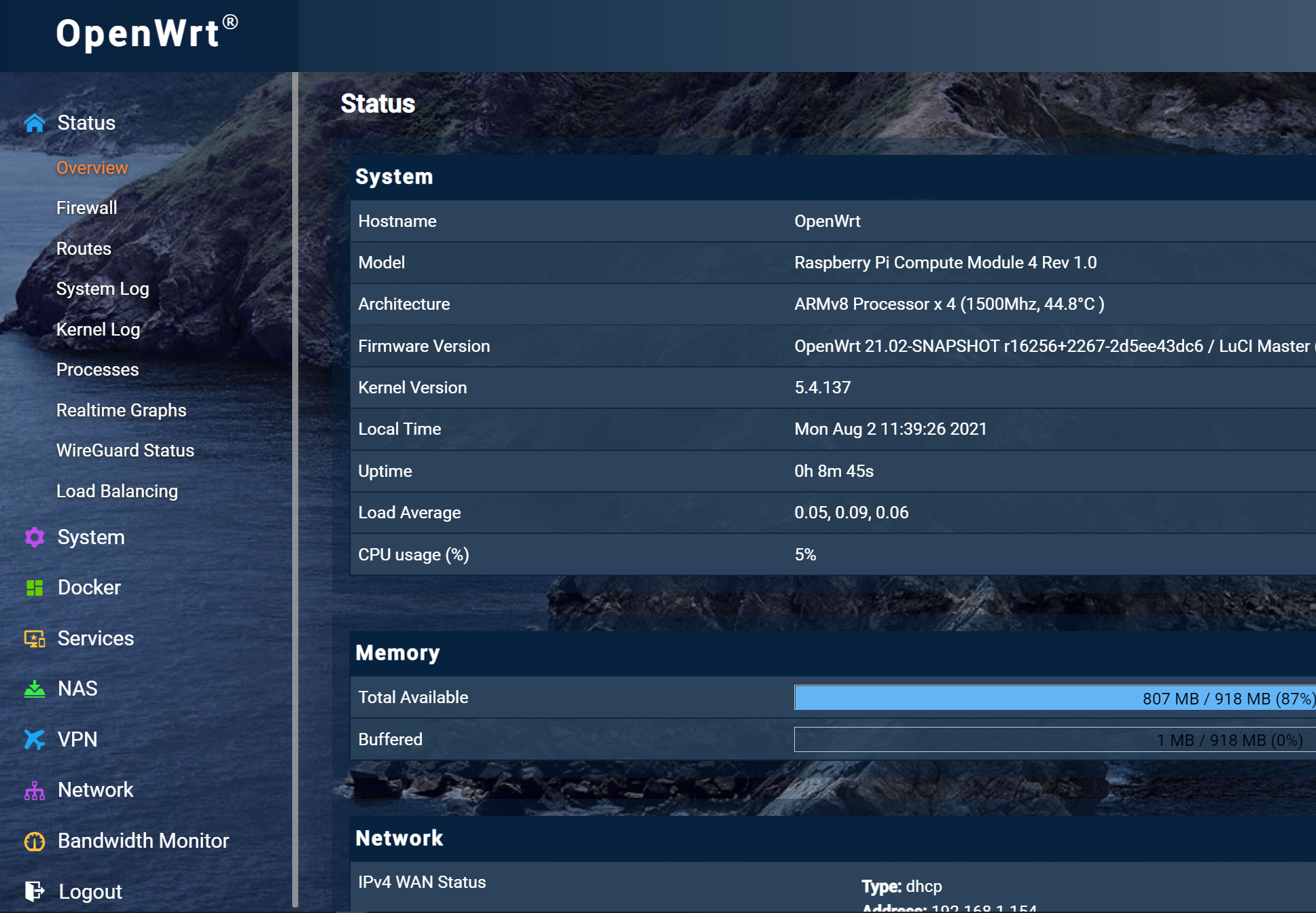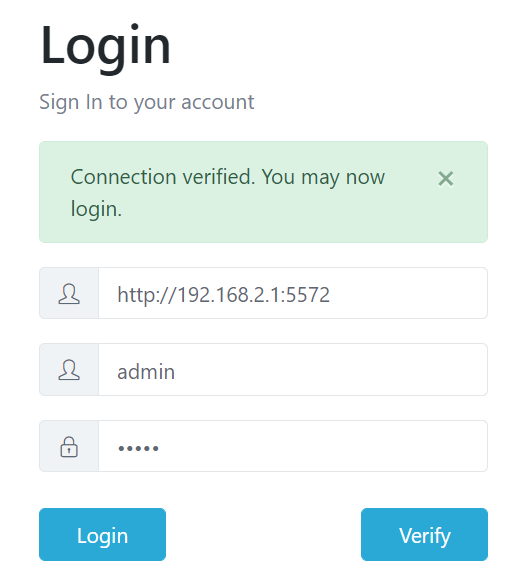Getting Started with OpenWrt on Your Router

This Mini Router is equipped with dual Gigabit Ethernet ports and dual USB 3.0 ports, making it suitable for soft router applications, while keeping the hardware to a minimum. We have pre-installed a Raspberry Pi Compute Module 4 with 4GB RAM and 32GB eMMC to enable fast boot-up times and a smooth overall experience.
Hardware Overview

Quick Start with Mini Router
OpenWrt Pre-Installed
The Compute Module 4 comes with OpenWrt Firmware out-of-the-box. This means you just need to unbox the package, take out the board, connect to your existing home network and have your own mini router!
OpenWrt is an open-source Linux operating system which runs on embedded devices/ routers. It offers more features, performance, and security than a traditional router. It has a filesystem that’s fully writable and includes a package management system. You can make use of these packages to suit your applications in various ways. Once you connect this board to your home network and access the router from a web browser, you will be presented with a beautiful and interactive dashboard as follows.
2 Step to run Mini Router with OpenWrt
Hardware Required
You need to prepare the following hardware before getting started with OpenWRT on Mini Router ● 1 x Mini Router ● 1 x Power adapter (5V/3A) with USB Type-C cable ● 2 x Ethernet cables
Instruction
Once the ethernet cables are connected, ● Step 1. Power on the board ● Step 2. Open a web browser and type 192.168.2.1 You will see the OpenWrt Luci web-interface here. The OpenWrt image compiled by Seeed is included with many packages out-of-the-box. So you can use these package to realize many applications!

FAQ
Q1 I can’t change root password on OpenWrt because of the read-only file system. How should I deal with it?
It can be solved by reflashing the image on to the eMMC.
Q2: What if I connect the OpenWrt router to my existing router which has a default gateway IP of 192.168.2.1?
Seeed OpenWrt image comes preconfigured with the necessary network settings. You might only need to change one network setting for the scenario which involves the Dual Gigabit Ethernet Carrier Board for Raspberry Pi CM4 connecting to your existing router, and the router has the default gateway IP set to 192.168.2.1 which is the same as the default gateway IP for OpenWrt. In this scenario, you need to change the default IP of LAN interface on OpenWrt as follows:
Step 1. Open a web browser and log in to the OpenWrt portal by typing 192.168.2.1
Step 2. Navigate to System > TTYD Terminal and login with root as the username
Step 3. Open the following file
vi /etc/config/network
- Step 4. Change the static IP address on the LAN interface as follows
config interface 'lan'
option type 'bridge'
option ifname 'eth0'
option proto 'static'
option ipaddr '192.168.3.1'
option netmask '255.255.255.0'
option ip6assign '60'
Note: Here the static IP is changhed to 192.168.3.1. However, you can type any IP address of your choice
- Step 4. Reboot the router
reboot
Q3: What if I have the Dual Gigabit Ethernet Carrier Board non-CM4 version and attach a CM4 without emmC?
If you want to use a Compute Module 4 without eMMC on the Dual Gigabit Ethernet Carrier Board, then you need to flash OpenWrt on to a micro-SD card and insert it into the board. Follow the steps below according to your operating system.
Step 1. Insert a micro-SD card to the computer using a micro-SD card reader connected to the computer, or by using a built-in card reader on a laptop
Step 2. Download balenaEtcher software by visiting this link according to your operating system
Step 3. Run balenaEtcher as administrator

Step 4. Click Flash from file and point to the OpenWrt image file that you downloaded before
Step 5. Click Select target and select the connected micro-SD card
Step 6. Finally, click Flash!

Please wait a few minutes until the flashing process is complete.
- Step 7. Eject the micro-SD card from computer and insert it into the Dual Gigabit Ethernet Carrier Board

Q4: I cannot successfully set up Rclone from web UI
Rclone is a program to manage files on cloud storage drives. You can use it to make sure your cloud files are always in sync with the local storage.
Eventhough there is a UI to configure Rclone within OpenWrt Luci interface, you need to first do all the configurations within a command line. After that only you will be able to view your files by using the web UI.
Please follow the steps below:
Step 1. Visit OpenWrt Luci web UI and navigate to
Services > TerminalStep 2. Log in with your OpenWrt credentials
Step 3. Start the rclone configuration process by typing the following
rclone config
Step 4. Press n and press Enter to create a new remote.
Step 5. Type a name of your choice for the new remote

- Step 6. Find the type of storage you are creating a remote connection to, and enter the corresponding number from the long list

Note: Here number 13 is chosen for Google Drive as an example
Step 7. When you are prompted for a Client ID, press Enter to accept the default
Step 8. When you are prompted for a Client Secret, press Enter to accept the default
Step 9. Choose 1 as the scope that rclone should use when requesting access from the drive

Note: This will give full access to all the files in the drive
Step 10. When you are prompted for root folder ID, press Enter to accept the default
Step 11. When you are prompted for service account credentials JSON file path, press Enter to accept the default
Step 12. On Edit advanced config prompt, press Enter which selects No by default
Step 13. On Use auto config menu, press n and then press Enter
Step 14. Copy and paste the link shown on a web browser

Step 15. Sign in to your Google account and Allow access
Step 16. Copy the code shown on the Google sign in page and paste it inside the command line that we used before
Step 17. On Configure as a team drive press Enter to accept the default
Step 18. Press Enter to confirm the creation of the remote
You will see the output as follows:

Step 19. Type q to quit the configuration
Step 20. Navigate to
NAS > Rclone, check the box next to run Rclone as daemon and click SAVE & APPLYStep 21. Copy the rclone address

Step 22. Click WEBUI REACT and a new web page will open
Step 23. Paste the previously copied rclone address on to the first blank column
Step 24. Type admin for both username and password, and press Verify
You will see the following output if the connection is verified

Step 25. Click Login and go to Explore from the side menu
Step 26. Type the name of the remote we created before and click Open

Now you will see all your files in available in your drive
Q5: How do I fix my device when I faced the "Read Only Root filesystem"?
For devices in the "Read Only Root filesystem", we can use e2fsck to check the system and fix it. Please open the terminal window and run the following command:
e2fsck /dev/mmcblk0p2
Resources
[Web Page] OpenWrt Offficial Documentation
[GitHub] Seeed OpenWrt
[OneDrive] Seeed OpenWrt Images
Tech Support
Please submit any technical issue into our forum.
